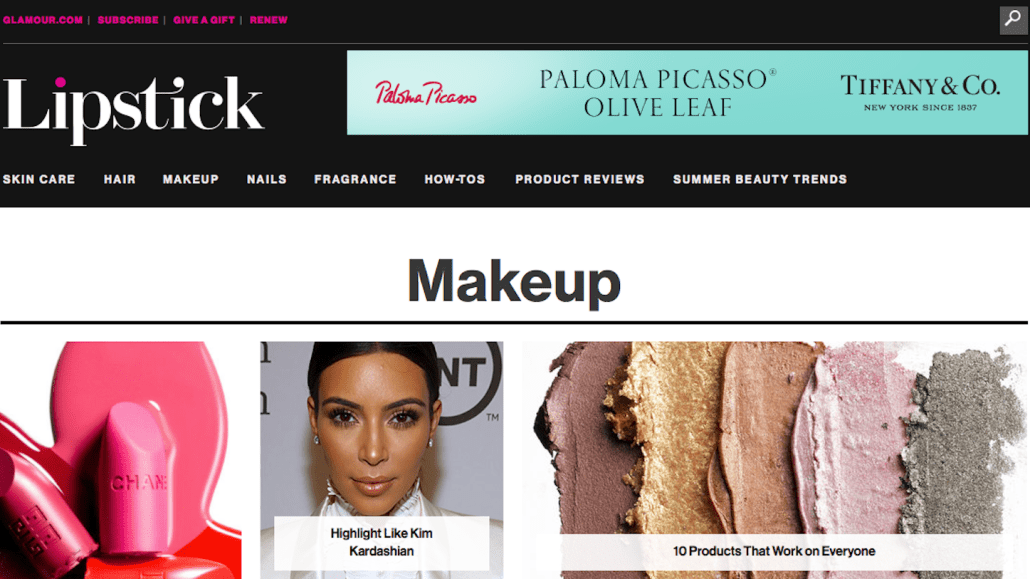Save 50% on a 3-month Digiday+ membership. Ends Dec 5.

One of the issues The New York Times’ digital-innovation report spotlighted was the paper’s deficiencies in cultivating readers who come to its site through search and social media.
Glamour is one publisher that’s starting to crack this code — and it’s leaning heavily on crunching data to make the content experience fit the context. The Condé Nast fashion and beauty magazine has examined traffic to its website and found that at different times of day, people are visiting the site for different reasons. So rather than have writers file all their stories at night for posting first thing in the morning, Glamour has finessed its approach, not unlike dayparting in broadcast TV programming.
“We’ve come to see that there are interesting patterns, and it’s come to inform what we do,” said Glamour executive digital director Mike Hofman.
The most obvious outcome of this strategy was Lipstick, a mobile-first beauty vertical that Glamour launched in April. The site was designed for the large number of readers who come to the site from mobile devices (more than half of Glamour’s 7.5 million monthly uniques), particularly those who come for beauty content. There are mobile- and beauty-specific features, like an Ideas button that provides advice for on-the-go beauty issues and a tap-to-buy function. Knowing beauty readers are likely to come through Pinterest, Glamour makes sure to pin a lot of its beauty content on the scrapbooking site.
In its first month, traffic to Lipstick was 40 percent above that of Glamour’s former beauty channel (which now redirects to Lipstick), according to Hofman.
Fashion and dating content has been getting the dayparting treatment, too.
Glamour, using data from Parse.ly, Omniture and Chartbeat, saw fashion readers tend to come in around lunchtime and again at night, when they’re planning their outfit for the next day. They tend to read on the desktop, whose bigger screen is better suited to perusing outfits than smartphones. They also have their preferred celebrities (those known for their fashion cred, like Kate Middleton and Victoria Beckham).
Ad position: web_incontent_pos1
“She wants to look at big, beautiful imagery,” Hofman said. “For us, it’s like, wow, we should be programming the homepage to drive the fashion-page story at lunchtime.”
For the evening visitor, Glamour also makes sure it has a quick outfit idea post like this one ready to go.
Further along in the day, around 2 p.m., traffic to Glamour’s celebrity content spikes. Entertainment-seekers typically come from Facebook via their smartphone and look for updates on stars like Jennifer Lawrence and Bradley Cooper. Glamour started posting later in the day, which led to an 11 percent increase in unique visitors and 23 percent lift in pageviews to its entertainment channel.
People looking for dating content tend to come in the evening, especially Sunday and Monday, when traffic to relationship content rises. By tweeting out sex and dating stories after 8 p.m., Glamour saw those stories perform about 50 percent better on the basis of click-throughs or site referrals than those tweeted out in the morning or afternoon.)
In addition to changing the content mix throughout the day, Glamour also has been looking at the content itself. It has begun to differentiate story template by section (Lipstick, for instance, plays up the photography for its beauty content), and write headlines for the device. So a headline written for mobile might be shorter or more playful than that meant for a desktop or in the form of a question. Creating content for the device can’t be far behind.
Ad position: web_incontent_pos2
“The way people use and play with language on mobile devices is different from a traditional desktop site,” Hofman said. “There’s more of a willingness and openness to voice, sense of humor. And I think people want things to be pithy.”
Publishers are just beginning to respond to the increasing role search and social are playing in how readers find their content, though, said Uyen Tieu, co-founder and chief revenue officer of Rumble, a mobile publishing platform. Immersive features like the Times’ Snowfall are nice, but the most successful digital publishers are focused on tagging their content so it gets found, she said.
“It’s very important to have great user experience, but content is everywhere,” she said. “Discoverability is going to be just as important. The benefit is higher engagement and with higher engagement, you’re able to monetize a lot better. People in the publishing space feel so under attack that they don’t see what a big opportunity it can be.”
More in Media

Digiday+ Research Subscription Index 2025: Subscription strategies from Bloomberg, The New York Times, Vox and others
Digiday’s third annual Subscription Index examines and measures publishers’ subscription strategies to identify common approaches and key tactics among Bloomberg, The New York Times, Vox and others.

From lawsuits to lobbying: How publishers are fighting AI
We may be closing out 2025, but publishers aren’t retreating from the battle of AI search — some are escalating it, and they expect the fight to stretch deep into 2026.

Media Briefing: Publishers turn to vertical video to compete with creators and grow ad revenue in 2026
Publishers add vertical video feeds to their sites to boost engagement, attract video ad spend and compete with news creators.
Ad position: web_bfu





